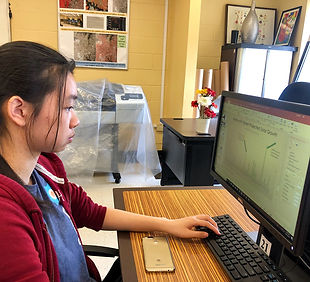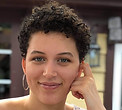BCC Geospatial Center of the CUNY CREST Institute

About BGCCCI
The Bronx Community College Geospatial Center of the CUNY CREST Institute [BGCCCI] is a leading institution in New York City. The Center has been promoting scientific research and education in geospatial technology since 2014. Founded independently from the ground up by Dr. Sunil Bhaskaran, the Geospatial Center at Bronx Community College—part of the CUNY CREST Institute is dedicated to advancing cutting-edge research, education, and workforce development in geospatial technologies. Our mission is to empower students and educators across the K–16 continuum through inclusive, interdisciplinary learning and hands-on training. We strive to lead transformative research by fostering strategic partnerships with industry, government, and academia, creating an innovation ecosystem rooted in collaboration and impact. Through our programs, we aim to chart clear career pathways in geospatial science, promote equity and access, and shape the next generation of professionals driving solutions to global challenges.
Our Story
The Bronx Community College Geospatial Center of the CUNY CREST Institute (BGCCCI) was built from the Ground Up . It was established as a collaborative satellite center under the CUNY CREST Institute and was officially launched as a CUNY Institute after a Memorandum of Understanding was signed on 3 October, 2014 between the Bronx Community College and the CUNY CREST Institute (City College of New York). The need for the Center was driven and incentivized by implementing cross-cutting activities from 2010 on BCC campus. These activities consisted of focused undergraduate research, multidisciplinary collaborations, out-of-classroom research internships, preparation of grant proposals, national and international collaborations and working proactively with an industry consortium to build career pathways. They were implemented by working with a range of stakeholders including CUNY campuses, national and international institutions, administrators, federal and private agencies, community and an industry consortium. The Center has been sustained by numerous extramural grant awards from the United States National Science Foundation, National Aeronautics and Space Administration (NASA) and private sector. The Center has trained over 500 participants and conducted cutting-edge research projects in collaboration with national and international stakeholders and partnering institution
Cross Cutting Activities
The Center's affiliated faculty, collaborators, and staff conduct cutting-edge research, conduct research internships, professional development programs, hands-on workshops in applied geospatial technology.
Research-Thematic Areas
Disaster mitigation and policy decision support – Multi-resolution approach
High population densities and infrastructure in cities make them extremely vulnerable to disasters that challenge their ability to mitigate and adapt and enhance their resilience. A data-centric approach to map complex relationships between the city’s social, economic, political and administrative components is critical to manage disasters and plan mitigation and adaptation efforts. A multi-resolution approach and data integration is essential to plan and model the city’s ability to mitigate and adapt to extreme weather events. At the Center we use a range of spectral and spatial resolutions [VIS-NIR-SWIR] facilitated by remotely sensed data sets to model the City processes at all scales.
Bhaskaran, S., Datt, B. S., Forster, B., Neal, T. and Brown, M. (2004), International Journal of Remote Sensing “Potential of Imaging spectroscopy and GIS for Hail-storm disaster mitigation”, Vol. 25:13, pp. 2625–2639. Publishers: Taylor and Francis.

Per-pixel to Object-based approaches for decoding the Urban environment from space
Urban areas are characterized by unplanned growth, sprawl, frequent land cover and land use changes, and population concentrations. Planning urban areas requires accurate information over space and time. A wide array of remotely sensed data acquired from spaceborne and airborne platforms offer great promise in modeling urban environments. However spectral confusion caused by mixed signals makes feature extraction from urban satellite datasets challenging and inaccurate. We have developed models to extract urban features by using a combination of per-pixel and object-based approaches to extract features based on their spectral and spatial attributes. The extracted features may be used for various applications ranging from human health and environment to climate change and disaster management.
Bhaskaran, S., Paramananda, S., Ramnarayan, M., Per-pixel, and object-oriented classification methods for mapping urban features using Ikonos satellite data, Applied Geography, 30 (2010), 650–665.

Foundation models for detecting patterns and ‘What If Scenarios’ from spaceborne and airborne multispectral imagery
Global solutions demand the analyses of BIG DATA acquired from multiple sensors. The volume of data is disproportionately matched by the quantum of analyses performed. The availability of large volumes of data and their global spatio-temporal coverage may be harnessed by innovative methods of classification and a multi-modal approach consisting of machine learning, deep learning and customized neural network architectures. We build foundation models by using combination of unsupervised, supervised, per-pixel, object-based machine learning, deep learning, NN techniques and by testing the model on global datasets use them to design and build solutions for a wide range of issues [Climate Change, Urban planning, disaster management, policy decisions
Arvind R. Sharma, Sunil Bhaskaran, Deriving community vulnerability indices by analyzing multi-resolution space-borne data and demographic data for extreme weather events in global cities, Remote Sensing Applications: Society and Environment, Volume 33, 2024,101086, ISSN 2352-9385, https://doi.org/10.1016/j.rsase.2023.101086.

Urban Heat Island Mitigation
Urban heat islands demand rapid solutions and nature-based solutions for their mitigation and adaptation. At the Center we work with a range of spaceborne imagery to derive Land Surface Temperature [LST] to map concentrations of heat islands in designated disadvantaged zone of New York City boroughs. By fine tuning the satellite-based retrievals with fine resolution field data acquired from portable and static temperature | weather monitoring stations and using AI and statistical techniques we derive mitigation and adaptation policies and informed decision making processes at borough and city scales.
Shahfahad, Talukdar, S., Rihan, M. et al. Modelling urban heat island (UHI) and thermal field variation and their relationship with land use indices over Delhi and Mumbai metro cities. Environ Dev Sustain 24, 3762–3790 (2022). https://doi.org/10.1007/s10668-021-01587-7
Green House Gas [GHG] retrievals and Air Pollution reduction and Mitigation
GHGs cause global warming and impact the health of all living species and the environment. Modelling the source and propagations of anthropogenic GHGs is critical to avoid induced climate change. Air pollution causes respiratory issues and endangers the lives of all species. Reducing pollution and its impact is important for environmental sustainability. Spaceborne and field based monitoring systems are important for monitoring and investigating the source of pollution and modeling its retrieval accurately for informed decisions and policy development. We use a multi-sensor approach with deep learning and machine learning techniques for retrieving and modeling air pollutants [Aerosols, Nitrogen Dioxide]. Our approach is to work with the impacted communities for developing solutions for mitigation and adaptation from local to global levels.
Bhaskaran, S., Phillip, N., Rahman, A., Mallick J. (2011), Applications of satellite data for Aerosol Optical Depth (AOD) retrievals and validation with AERONET data. Atmospheric and Climate Sciences, 2011, 4, 47–53 doi:10.4236/acs.2011.12006.

Modeling Urban LULC changes.
Land Cover and Land Use [LULC] influence planning and policy development. However they need to be monitored at all scales for measuring changes caused by biophysical changes attributed to population growth, disasters, climate change events, and commercial development. LULC influences the use of natural resources and needs to be modeled for optimizing resources and building sustainable goals. We design predictive models using AI, Machine Learning and Deep Learning algorithms for investigating LULC changes and impacts.
Sunil Bhaskaran, Eric Nez, Karolyn Jimenez & Sanjiv K. Bhatia (2012): Rule-based classification of high-resolution imagery over urban areas in New York City, Geocarto International, DOI: 10.1080/10106049.2012.726278 first article: 1–19.

Geospatial-AI conference
Visitors at the Center
Research Internship Reports








Dr. Sunil Bhaskaran
Founding Director, BGCCCI | Professor, CUNY (BCC & Graduate Center)
Dr. Sunil Bhaskaran is a leading expert in Geospatial Technology and Environmental Sciences with over 25 years of experience in academia and industry. He specializes in advanced satellite image analysis using per-pixel, object-based, and machine learning approaches. His work spans disaster management, urban planning, and climate change applications.
In Australia, Dr. Bhaskaran developed a semantic urban disaster management system with the New South Wales Fire Brigades and served on key national remote sensing committees. In the U.S., he has been instrumental in advancing Geospatial Technology at CUNY. He founded the Bronx Community College Geospatial Center of the CUNY CREST Institute (BGCCCI) in 2014, leading it to become a nationally recognized Center of Excellence with support from NSF, NASA, and industry partners. Dr. Bhaskaran currently serves on the EPA's Federal Board of Scientific Counselors and multiple CUNY research committees. He is widely published, grant-funded, and has been honored multiple times for his contributions to CUNY. He proudly embraces his Indian heritage and holds dual citizenship in the U.S. and Australia.











.jpg)










